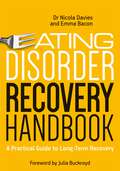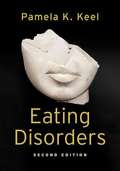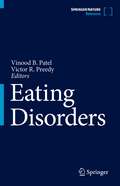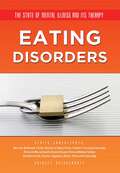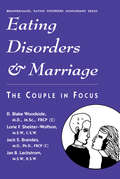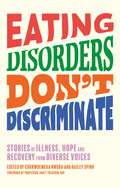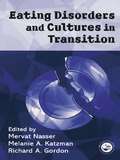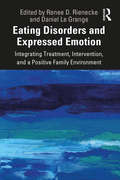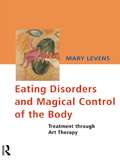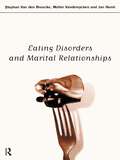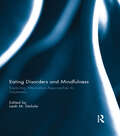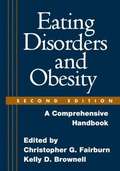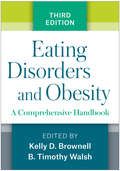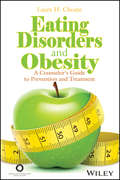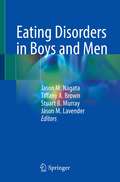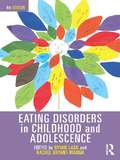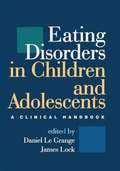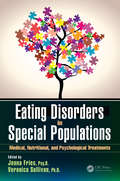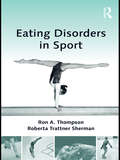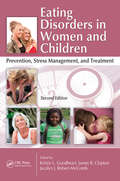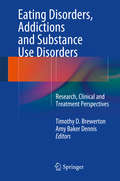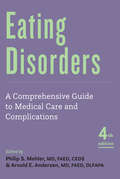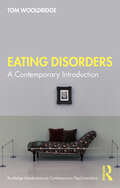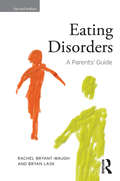- Table View
- List View
Eating Disorder Recovery Handbook: A Practical Guide to Long-Term Recovery
by Emma Bacon Dr Nicola DaviesThis empathetic handbook has been created for people affected by any form of disordered eating. Thoughtfully compiled by experienced authors, it will be a comprehensive guide through every stage of your recovery, from recognising and understanding your disorder and learning fully about treatment, to self-help tools and practical advice for maintaining recovery and looking to the future. Each chapter includes suggested objectives, tasks and reflections which are designed to help you think about, engage with, and express your thoughts, feelings and behaviours. It will encourage you to process the discoveries you make about yourself for positive and long-lasting change. Encouraging quotes are included throughout from people who have walked this path and found the help they needed to overcome their own disordered eating. You are not alone on this journey.
Eating Disorders
by Pamela K. KeelEating Disorders presents a comprehensive and accessible investigation of eating disorders, spanning topics such as historical and cross-cultural trends in prevalence of eating pathology, biological bases of eating disorders, and treatment and prevention. It provides an examination of the intersections of culture, mind, and body, and includes case studies throughout, helping bring eating disorders to life. This second edition is fully revised and updated to reflect changes in the DSM-5 as well as research and practice advances that have occurred over the past decade. <p><p> Specifically, the second edition provides coverage of newly named syndromes, a new chapter on feeding disorders and obesity, an expanded discussion of RDOC initiative, expanded coverage of eating disorders in men, a section on mediators and moderators of treatment response, a section of suggested additional sources that includes articles, books, movies, and on-line sources for reliable and accurate information, a new description of cognitive behavior therapy that outlines what CBT for bulimia nervosa looks like as experienced from the patient's perspective, and a new discussion of prevalence and risk of dietary supplements. <p> The book will be useful in abnormal psychology, clinical psychology, gender and psychopathology, and eating disorders courses, and as a supplemental text in courses within nursing, nutrition, and sports medicine.
Eating Disorders
by Victor R. Preedy Vinood B. PatelEating disorders can profoundly affect the individual and family unit. Changes in the individual include disturbances in body perception, organ damage, and increased risk factors leading to ill-health in later years. There is thus a fundamental requirement to adequately diagnose, treat and manage those individuals with eating disorders which the American Psychiatric Association have recently categorized (DSM-5) into Anorexia Nervosa, Bulimia Nervosa, Binge Eating Disorder, and Other Specified- and Unspecified-Feeding or Eating Disorders.The aim of this reference work is to describe, in one comprehensive resource, the complex relationships between eating disorders, diet, and nutrition. In this regard eating disorders are regarded as psychiatric conditions though there are some eating disorders that have a genetic basis. Genetic influences will also include polymorphisms. It will provide a framework to unravel the complex links between eating disorders and health-related outcomes and provide practical and useful information for diagnosis and treatment. The volume will also address macronutrients, micronutrients, pharmacology, psychology, genetics, tissue and organ damage, appetite and biochemistry, as well as the effect of eating disorders on family and community. The material will enhance the knowledge-base of dietitians, nutritionists, psychiatrists and behavioral scientists, health care workers, physicians, educationalists, and all those involved in diagnosing and treating eating disorders.
Eating Disorders (The State of Mental Illness and Its Ther)
by Shirley BrinkerhoffA high school student allows herself to eat less than six hundred calories a day. Months go by as her body withers. Her friends and family are aghast at her emaciated appearance. Nevertheless, she still agonizes over being "too fat." A college student regularly downs six or seven thousand calories in a single hour. Then she makes herself throw up before her body can digest the massive amount of food. Eating disorders like these affect five million people each year in America alone, and many more millions in other countries. Ninety percent of those who have eating disorders are females. More than ten percent of the people hospitalized with anorexia nervosa will die as a result of the disease. Eating Disorders tells the stories of two young women who struggle with anorexia and bulimia and how they found help. Although eating disorders are among the most difficult of psychiatric illnesses to treat, new advances in care are being made. Many individuals with eating disorders are helped by concerned health professionals and by treatment programs that use the latest medical, behavioral, and pharmacological therapies. In this book, you will learn about eating disorders, the devastating effects they can have, and the treatments that can bring hope back to sufferers' emaciated lives.
Eating Disorders And Marriage: The Couple In Focus Jan B. (Eating Disorders Monographs #No.8)
by D. Blake Woodside Lorie F. Shekter-Wolfson Jack S. Brandes Jan B. LackstromFirst published in 1994. Routledge is an imprint of Taylor & Francis, an informa company.
Eating Disorders Don’t Discriminate: Stories of Illness, Hope and Recovery from Diverse Voices
by Amanda Taylor Jessica Wilson Dave Chawner Megan Jayne Crabbe Hope Virgo Nigel Owens Lindsey Holland Dianne Buswell Smriti Mundhra Marilyn Okoro Selina Tossut Sam Layton George Mycock Lara Rebecca Afftene Ceri Taylor Ryan Sheldon Bobby Kasmire Cynthia Bulik Jasmine C. Leyva Clare Steedman Rachael Alder-Byrne Ro Mitchell Kristina Saffran Hana Brannigan James Downs Molly Bartrip Amalie Lee Becky Excell Eva Trujillo Shannon Dymond Laura Mae Ramsey Lee Chambers Sam Clark-Stone Bayadir Mohamed-Osman Raffela Mancuso Sophie BaverstockEating disorders know no boundaries. They don't discriminate.Every story of living with an eating disorder is unique. Eating Disorders Don't Discriminate brings together thirty-one of them, each tackling the stereotypes and misconceptions about what eating disorders look like and who they impact.Athletes, activists, directors, models, health professionals, and more share their experiences of eating disorders, including binge eating disorder, bulimia nervosa, anorexia nervosa, ARFID and OSFED, and highlight the complexities of how race, gender, culture and social media can influence our experiences of body and food.Compiled by Dr Chuks Nwuba, who has cared for some of the UK's most unwell eating disorder patients, and TikToker and eating disorder advocate Bailey Spinn, this stirring anthology is one of hope and encouragement for anyone who feels misunderstood and underrepresented. With writing from:Rachael Alder-Byrne - Molly Bartrip - Sophie Baverstock - Hana Brannigan - Cynthia Bulik - Dianne Buswell - Lee Chambers - Dave Chawner - Sam Clark-Stone - Megan Jayne Crabbe - James Downs - Shannon Dymond - Emme - Becky Excell - Lindsey Holland - Bobby Kasmire - Sam Layton - Amalie Lee - Raffela Mancuso - Ro Mitchell - Bayadir Mohamed-Osman - Smriti Mundhra - George Mycock - Marilyn Okoro - Nigel Owens - Jasmine C. Perry - Laura Mae Ramsey - Lara Rebecca - Kristina Saffran - Selly - Ryan Sheldon - Clare Steedman - Afftene Ceri Taylor - Amanda Taylor - Eva Trujillo - Hope Virgo - Jessica Wilson
Eating Disorders and Cultures in Transition: Edited By Mervat Nasser, Melanie A. Katzman, Richard A. Gordon
by Mervat Nasser Melanie A. Katzman Richard A. GordonEating disorders: do they mark cultural transition? Eating disorders that were once viewed as exclusive to specific class and ethnic boundaries in western culture are now spreading worldwide. This issue is fully discussed in this groundbreaking volume. Eating Disorders and Cultures in Transition is written by an international group of authors to address the recent emergence of eating disorders in various areas of the world including countries in South America, Asia, Africa and Eastern Europe. It offers an in-depth analysis of the existing socio-cultural model arguing for the need to extend both our theoretical understanding and clinical work to account properly for this global phenomenon. Eating disorders are seen as reflecting sweeping changes in the social and political status of women in the majority of societies that are now undergoing rapid cultural transition. This multidisciplinary, multinational volume reflects wide-ranging, intellectually stimulating and frequently provocative viewpoints. It promises to be of great interest to medical and mental health professionals, public policy experts and all those watching for the processes of cultural transformation and their impact on mental health.
Eating Disorders and Expressed Emotion: Integrating Treatment, Intervention, and a Positive Family Environment
by Daniel Le Grange Renee D. RieneckeThe first to synthesize the exponentially growing research on expressed emotion (EE) and eating disorders and apply it to treatment, interventions, and other scenarios, this unique text provides unprecedented guidance to students, clinicians, and researchers in the field of eating disorders. This book explores the components of relatives’ attitudes and behaviors toward an ill family member and discusses a modifiable treatment target that could improve outcomes for patients through interventions, treatment plans, and future directions in research. Chapters bring together contributions from eminent scientists and clinicians in the fields of families, eating disorders, and treatment to contribute to the clinical and scholarly understanding of expressed emotion and eating disorders. Mental health professionals studying and treating eating disorders will find this text to be a valuable reference guide and will be inspired to further explore this rich and promising area of study.
Eating Disorders and Magical Control of the Body: Treatment Through Art Therapy
by Mary LevensPeople with eating disorders often make desparate attempts to exert magical control over their bodies in response to the threats they experienced in relationships. Mary Levens takes the reader into the realm of magical thinking and its effect on ideas about eating and the body through a sensitive exploration of the images patients create in art therapy, in which themes of cannibalism constantly recur. Drawing on anthropology, religion and literature as well as psychoanalysis, she discusses the significance of these images and their implications for treatment of patients with eating disorders.
Eating Disorders and Marital Relationships
by Walter Vandereycken Jan Norre Stephan Van den BrouckeAnorexia and bulimia are on the increase in the Western world and the disease is now recognised to no longer be only a problem for teenage girls, but older women as well. Most older women either do now or did previously live with a partner and much attention has been paid to these relationships in devising therapeutic regimes.Eating Disorders and Marital Relationships takes a critical look at the evidence behind the assumption of psychiatric illness in the patients and their partners and comes up with some surprising results. Van den Broucke, Vandereycken and Norre carefully describe both the theoretical and practical implications of their work, making this book important reading for both practitioner and researcher.
Eating Disorders and Mindfulness: Exploring Alternative Approaches to Treatment
by Leah M. DeSoleThis book presents an overview of the latest psychological knowledge about the application of mindfulness-based interventions in the field of eating disorders. Increasingly, these interventions are used in therapeutic practice. They encourage clients to process their experience fully, as it arises, without judgement. Mindfulness-based approaches, in particular, emphasize the cultivation of moment to moment awareness of thoughts and feelings as well as bodily sensations. In so doing, eating disorders present an ideal context for the development of mindfulness. Indeed, it is in the body that the emotional and relational struggles of clients reveal themselves. The authors in this diverse volume share a belief in the utility of using mindfulness-based practices to address disordered eating. It features up to date research and theory regarding mindfulness and the full spectrum of eating disorders, from Anorexia Nervosa and Bulimia Nervosa to Binge Eating Disorder. In addition, it explores how professionals can utilize mindfulness in their own practices, in the context of both individual and group treatment.This book was originally published as a special issue of Eating Disorders: the Journal of Treatment and Prevention.
Eating Disorders and Obesity, Second Edition
by Christopher G. Fairburn Kelly D. BrownellThis unique handbook presents and integrates virtually all that is currently known about eating disorders and obesity in one authoritative, accessible, and eminently practical volume. From leading international authorities, 112 concise chapters encapsulate the latest information on all pertinent topics, from biological, psychological, and social processes associated with risk, to clinical methods for assessment and intervention. Suggestions for further reading at the end of each chapter replace extended references and enhance the practical value and readability of the volume.
Eating Disorders and Obesity, Third Edition: A Comprehensive Handbook
by Kelly D. Brownell B. Timothy WalshAcclaimed for its encyclopedic coverage, this is the only handbook that synthesizes current knowledge and clinical practices in the fields of both eating disorders and obesity. Like the prior editions, the significantly revised third edition features more than 100 concise, focused chapters with lists of key readings in place of extended references. All aspects of eating disorders and obesity are addressed by foremost clinical researchers: classification, causes, consequences, risk factors, and pathophysiology, as well as prevention, treatment, assessment, and diagnosis. New to This Edition *Reflects 15 years of important advances in both fields, including state-of-the-art intervention approaches and a growing focus on how the brain regulates eating behavior. *Dozens of entirely new chapters. *New topics: epigenetics, body weight and neurocognitive function, stress and emotion regulation, the gut microbiome, surgical devices for obesity, food labeling and marketing, and more. *Expanded coverage of prevention and policy.
Eating Disorders and Obesity: A Counselor's Guide to Prevention and Treatment
by Laura H. ChoateBoth practical and comprehensive, this book provides a clear framework for the assessment, treatment, and prevention of eating disorders and obesity. Focusing on best practices and offering a range of current techniques, leaders in the field examine these life-threatening disorders and propose treatment options for clients of all ages. This text, written specifically for counselors, benefits from the authors’ collective expertise and emphasizes practitioner-friendly, wellness-based approaches that counselors can use in their daily practice. Parts I and II of the text address risk factors in and sociocultural influences on the development of eating disorders, gender differences, the unique concerns of clients of color, ethical and legal issues, and assessment and diagnosis. Part III explores prevention and early intervention with high-risk groups in school, university, and community settings. The final section presents a variety of treatment interventions, such as cognitive–behavioral, interpersonal, dialectical behavior, and family-based therapy. *Requests for digital versions from the ACA can be found on wiley.com. *To request print copies, please visit the ACA website here. *Reproduction requests for material from books published by ACA should be directed to permissions@counseling.org.
Eating Disorders and the Skin
by Renata StrumiaAt least 40 skin signs are associated with eating disorders (EDs), and some of them are considered guiding signs because they are indicative of an otherwise hidden ED. The role of the dermatologist in this context is to suspect the presence of a hidden ED based on these guiding signs. With this in mind, the most important specialists in the field come together in this book to document all of the dermatological aspects of EDs. General topics such as classification of EDs, epidemiology, and medical complications are first addressed, and skin signs attributable to various causes are then discussed in a series of detailed chapters. Characteristic changes in the hair, nails, and oral cavity are also carefully documented, and the closing chapters address various other related issues of interest. "Eating Disorders and the Skin" will be an invaluable source of up-to-date information for both novice and experienced dermatologists, as well as other practitioners, psychiatrists, and nurses.
Eating Disorders in Boys and Men
by Jason M. Nagata Tiffany A. Brown Stuart B. Murray Jason M. LavenderBoys and men with eating disorders remain a population that is under-recognized and underserved within both research and clinical contexts. It has been well documented that boys and men with eating disorders often exhibit distinct clinical presentations with regard to core cognitive (e.g., body image) and behavioral (e.g., pathological exercise) symptoms. Such differences, along with the greater likelihood of muscularity-oriented disordered eating among boys and men, emphasize the importance of understanding and recognizing unique factors of clinical relevance within this population.This book reviews the most up-to-date research findings on eating disorders among boys and men, with an emphasis on clinically salient information across multiple domains. Five sections are included, with the first focused on a historical overview and the unique nature and prevalence of specific forms of eating disorder symptoms and body image concerns in boys and men. The second section details population-specific considerations for the diagnosis and assessment of eating disorders, body image concerns, and muscle dysmorphia in boys and men. The third section identifies unique concerns regarding medical complications and care in this population, including medical complications of appearance and performance-enhancing substances. The fourth section reviews current findings and considerations for eating disorder prevention and intervention for boys and men. The fifth section of the book focuses on specific populations (e.g., sexual minorities, gender minorities) and addresses sociocultural factors of particular relevance for eating disorders in boys and men (e.g., racial and ethnic considerations, cross-cultural considerations). The book then concludes with a concise overview of key takeaways and a focused summary of current evidence gaps and unanswered questions, as well as directions for future research. Written by experts in the field, Eating Disorders in Boys and Men is a comprehensive guide to an under-reported topic. It is an excellent resource for primary care physicians, adolescent medicine physicians, pediatricians, psychologists, clinical social workers, and any other professional conducting research with or providing clinical care for boys and men with eating disorders. It is also an excellent resource for students, residents, fellows, and trainees across various disciplines.
Eating Disorders in Childhood and Adolescence: 4th Edition
by Bryan Lask Rachel Bryant-WaughIn the fourth edition of this accessible and comprehensive book, Bryan Lask and Rachel Bryant-Waugh build on the research and expertise of the previous three editions. First published in 1993, this was the first book of its kind to explore eating disorders in children and young adolescents, a population that is very different from those in their late teens and adulthood. The contributors’ experience and knowledge have increased and the field has moved forward over the past 20 years. This fully revised edition offers a distillation of current information relating to the younger population, and contains brand new chapters on areas of experience, research and practice including: The perspective of a young person going through an eating disorder Experiences of a parent Updated information regarding advances from neuroscience Therapeutic engagement Cognitive remediation therapy Eating Disorders in Childhood and Adolescence offers the reader knowledge, insight and understanding into this fascinating but challenging patient group. It has both a clinical and research focus and will be an essential text for a wide range of professionals, as well as being readable for parents of children suffering from eating disorders.
Eating Disorders in Children and Adolescents
by Daniel Le Grange James LockBringing together leading authorities, this comprehensive volume integrates the best current knowledge and treatment approaches for eating disorders in children and adolescents. The book reveals how anorexia nervosa, bulimia nervosa, and other disorders present differently developmentally and explains their potentially far-reaching impact on psychological, physical, and neurobiological development. It provides guidelines for developmentally sound assessment and diagnosis, with attention to assessment challenges unique to this population. Detailed descriptions of evidence-based therapies are illustrated with vivid case examples. Promising directions in prevention are also addressed. A special chapter offers a parent's perspective on family treatment.
Eating Disorders in Special Populations: Medical, Nutritional, and Psychological Treatments
by Jonna Fries Veronica SullivanEating disorders are among the most complex disorders to treat, typically requiring medical, nutritional, and psychotherapeutic interventions. High relapse rates and the sense of urgency to save lives and minimize or prevent lifelong problems present challenges for even the most seasoned treatment providers.In an engaging, clear, and concise manner, Eating Disorders in Special Populations: Medical, Nutritional, and Psychological Treatments prepares physicians, dietitians, and psychotherapists to navigate the labyrinth they enter with eating disordered patients. Aggregating a vast amount of information and perspectives in a clear and concise format, readers will gain insight into the minds on both sides of the treatment room.From leading experts in the field, readers will learn how dietitians, physicians, and psychotherapists conceptualize and treat people with eating disorders, and treatment providers will discover the nuanced etiologies of eating disorder symptoms in a range of diverse populations. Increase your cultural competency and expand your practice by learning how eating disorders are created, maintained, and resolved. Join us in bringing light, health, and hope to our patients and to our colleagues across disciplines.
Eating Disorders in Sport
by Ron A. Thompson Roberta Trattner ShermanOver the past fifteen years, there has been a great increase in the knowledge of eating disorders in sport and effective means of treatment. In this book, the authors draw on their extensive clinical experience to discuss how to identify, manage, treat, and prevent eating disorders in sport participants. They begin by examining the clinical conditions related to eating problems, including descriptions of specific disorders and a review of the relevant literature. Special attention is given to the specific gender and sport-related factors that can negatively influence the eating habits of athletes. The second half of the book discusses identification of participants with disordered eating by reviewing symptoms and how they manifest in sport; management issues for sport personnel, coaches, athletic trainers, and healthcare professionals; treatment; and medical considerations, such as the use of psychotropic medications. A list of useful resources is included in an appendix, as well as a glossary of important terms.
Eating Disorders in Women and Children: Prevention, Stress Management, and Treatment, Second Edition
by Ljubisa R. RadovicOur understanding of eating disorders has improved markedly over the past 10 years since the publication of the previous edition of this volume. Early intervention is the key, as body dissatisfaction, obsession with thinness, and restrained and binge eating can be found in those as young as ten. Exploring prevention methods and therapeutic options, the second edition of Eating Disorders in Women and Children: Prevention, Stress Management, and Treatment is updated with new research on these devastating maladies.Highlights in the second edition include: An emphasis on the physiology of eating disorders and genetic factors related to anorexia and bulimia Theories on prevention and the identification of at-risk individuals The latest information on therapeutic modalities, including cognitive behavioral, interpersonal, constructionist, and narrative approaches as well as pharmaceutical management Nutritional evaluation and treatment Specific exercise recommendations for women and children with eating disorders An accompanying downloadable resources containing a PowerPoint® presentation for each chapter With contributions from acclaimed clinicians widely known for their work with the eating disorder population, this volume recognizes the multifaceted nature of these disorders, addresses the widening demographic range of those afflicted, and delves into the issues behind their development. It provides practical recommendations for treatment from many perspectives, presenting enormous hope for people who painfully struggle with these disorders. In addition, it explores critical measures that can be taken to help the larger population understand and work to prevent eating disorders in their communities.
Eating Disorders, Addictions and Substance Use Disorders
by Timothy D. Brewerton Amy Baker DennisEating disorders, addictions, and substance use disorders are each challenging in their own right, but they also commonly co-occur, causing major challenges for clinicians. This book presents cutting-edge research on the overlap of these complex disorders and reviews integrative assessment strategies and treatment approaches, including enhanced cognitive behavioral therapy, dialectical behavior therapy, abstinence approaches, motivational enhancement, mindfulness meditation, and pharmacotherapy. The issue of whether eating-disordered behaviors such as dieting, binge eating, and excessive exercise are merely other forms of addictive behavior is examined. The authors argue both for and against the concept of food addiction in research, clinical treatment, and public policy. The book will be of interest to psychiatrists, addiction medicine physicians, mental health/substance abuse clinicians, dieticians, researchers, and those affected by the disorders.
Eating Disorders: A Comprehensive Guide to Medical Care and Complications
by Philip S. Mehler, MD, FAED, CEDS and Arnold E. Andersen, MD, FAED, DLFAPAA comprehensive guide on how to diagnose, treat, and care for those with eating disorders.Eating disorders, which include such conditions as anorexia, bulimia, binge eating, and pica, represent a challenge to both patients and health care providers alike. For more than 20 years, health care providers have turned to the expert advice found in Eating Disorders to keep up to date with the latest research in the field and to help them provide the best care available for their patients. In this new, thoroughly revised and expanded edition of their best-selling work, Drs. Philip S. Mehler and Arnold E. Andersen provide a user-friendly and comprehensive guide to treating and managing eating disorders for primary care physicians, mental health professionals, worried family members and friends, and nonmedical professionals (such as teachers and coaches). Mehler and Andersen • identify common medical complications faced by people who have eating disorders• answer questions about how to treat both physical and behavioral aspects of eating disorders• discuss serious complications, including cardiac arrhythmia, electrolyte abnormalities, and gastrointestinal problems• incorporate all-new information on avoidant restrictive food intake disorder (ARFID), binge eating disorder, and the role of social media in promoting disordered eating• offer targeted advice for working with specialists• include four new chapters on eating disorders in children and adolescents; atypical anorexia; eating disorders in transgender individuals; and family therapy• feature engaging clinical vignettes • answer a list of common questions practitioners may have in each chapterThe most comprehensive work on the market and the only book that covers eating disorders in transgender individuals, Eating Disorders is a compassionate, evidence-based, and essential guide.Contributors: Arnold E. Andersen, Ovidio Bermudez, Jeana Cost, Meghan Foley, Dennis Gibson, Neville Golden, Sacha Gorell, Jeffrey Hollis, Mori J. Krantz, Daniel Le Grange, Russell Marx, Jennifer McBride, Philip S. Mehler, Leah Puckett, Katherine Sachs, Michael Spaulding-Barclay, Anna Tanner, Nathalia Trees, Jessica Tse, Kenneth Weiner, Patricia Westmoreland
Eating Disorders: A Contemporary Introduction (Routledge Introductions to Contemporary Psychoanalysis)
by Tom WooldridgeThis book presents an accessible introduction to the conceptualization and treatment of eating disorders from a psychoanalytic perspective. Each of the chapters offers a different perspective on these difficult-to-treat conditions and taken together, illustrate the breadth and depth that psychoanalytic thinking can offer both seasoned clinicians as well as those just beginning to explore the field. Different aspects of how psychoanalytic theory and practice can engage with eating disorders are addressed, including mobilizing its nuanced developmental theories to illustrate the difficulties these patients have with putting feelings into words, the loathing that they feel towards their bodies, the disharmonies they experience in the link between body and mind, and even the ways that they engage with online Internet forums. This is an accessible read for clinicians at the start of their career and will also be a useful, novel take on the subject for experienced practitioners.
Eating Disorders: A Parents' Guide, Second edition
by Bryan Lask Rachel Bryant-WaughEating problems are common in children and teenagers. Yet myths about such problems abound and it can be very difficult to separate the facts from popular beliefs; unusual or disturbed eating patterns can be understandably bewildering and distressing for parents. Whatever aspect of your child's eating behaviour is causing you concern, this book will help you understand some of the more common reasons why problems arise, and will give you advice on what you and others can do to manage the situation. Written by two experienced clinicians, this new edition of Eating Disorders: A Parents' Guide is dedicated to clarifying the subject of eating disorders. Combining an accessible and straightforward introduction to the subject with practical advice, this book represents the first step towards recognising, understanding and dealing with the problem. Case-studies are used to help parents understand their children's experiences of this complex and challenging subject and sensitive advice is offered on a range of issues, including: how to identify a complete range of eating difficulties how to approach specific problems where to seek help and treatment. This book will be welcomed by anyone who is concerned about the eating habits of their children and will be invaluable to professionals working with those suffering from eating disorders.
